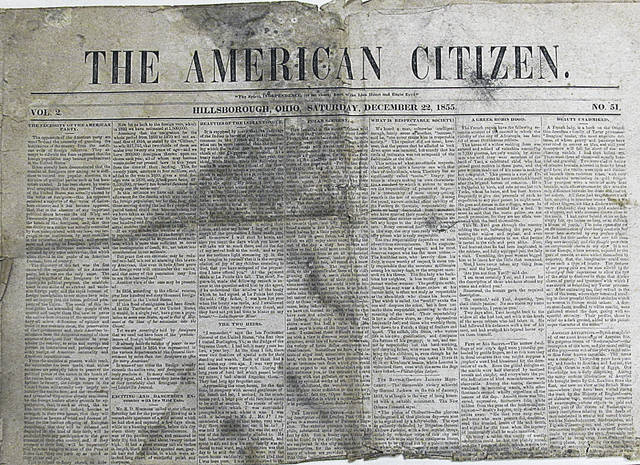
When Russ Roland purchased a Hillsboro home to start his Respiratory Health Care business in 1986, he found some items that piqued his interest in history.
“I went upstairs and was cleaning up and found four old newspapers and some old books up in the attic,” Roland said. “When I was growing up I was always into history. I really loved history, and there’s a lot of history in Hillsboro. They were just laying up there across the rafters. Some of them were so delicate they just fell apart.”
The house is located at 215 S. High St. Roland said that one time he believes it was used as an inn, and that the original owners were a family by the name of Darnelle. He said he believes Mr. Darnelle was a banker and that his wife was a school teacher.
The paper in the best condition was a Dec. 22, 1855 edition of a “Hillsborough” paper called The American Citizen. There were also Feb. 21, 1856; May 22, 1856; and May 29, 1856 editions of The Highland Weekly News, which was also a “Hillsborough” newspaper. Editor and proprietor J.L. Boardman touted The Highland Weekly News as a, “family newspaper — devoted to politics, literature, agriculture, domestic and foreign news, markets, etc.”
The small booklets include: “Col. David Mack, The Faithful Steward.” The cover says Steward died March 24, 1845 at the age of 94 in Middlefield, Mass. There is also “The Presbyterian Family Almanac 1852” and “George Lovell, An Authentic Narrative.”
The books deal mostly with religion, and the newspapers have little local content except for the advertisements. But The American Citizen, which was published each Saturday morning by W.W. Doggett and edited by Daniel Scott, has some local content of interest on its interior pages.
Here is one story from “a citizen” that was directed to Scott. It is reprinted as it was published:
“Having a day’s leisure, I have complied with your request, to furnish some estimates as to the cost of a Plank Road. It will be increased or modified as the cost of lumber and grading may vary in different localities.
“But a road from Hillsborough to Locust Grove, 10 feet in width, can be constructed for $1,500 per mile; from Hillsborough to Samantha, for about $1,600. A part of the latter road could be advantageously gravelled, instead of planking, and not vary the cost materially. As to the importance of both these roads, both to the farmers on and adjacent to the line, as well as to the commercial interest of Hillsborough, I suppose it needs no argument to show. The question is, will the parties interested make the effort and subscribe stock necessary to build the roads? I confess I have no faith in men’s patriotism, when the Almighty Dollar is concerned. And the only way to build either or both of these roads, is first to show that the scheme is practicable, and what it will pay; both of which I think can be done.
“1st. The road to Locust Grove — say it is 20 miles, which, at $1,500 per mile, will give $30,000. Take four mules on each side of the line of road, and you have eight miles in width, by twenty in length, which is 160 square miles, or 102,400 acres of land. From my observation, this embraces one of the best agricultural districts in the county. Allow 150 acres to each farmer in this tract, and you have 682 farmers. Make an assessment of twenty-five cents to each acre of land, and you have $37.50 to each farmer, and the result gives you $25,600, leaving $4,400 to be raised in Hillsborough and at Locust Grove.
“This, I look upon as practicable. — Will it pay?
“Suppose your 682 farmers cultivate annually 20 acres of wheat, and raise an average of 15 bushel per acre, and you have 13,640 acres of wheat sown, and 204,600 bushels raised. Retain 20,500 bushels for seed, and 31,000 bushels for bread, and you have 153,000 bushels of surplus wheat to market. I assume the average cost of delivery on every bushel of this wheat, at 10 cents. And I maintain it can more readily be done on a Plank Road at 5 cents, than now at 10. You thus save 5 cents on 153,000 bushels of wheat, which is $7,655 of yearly saving on wheat alone, and more than 25 percent interest on the cost of the road. Add to this, the surplus products other than wheat raised on these 682 farms, and to this the comfort and convenience of having a good road, the saving in wear and tear in harness, wagons and carriages, and if the farmer thinks it will not pay, then they must trudge along in the old way, until another generation comes up in their stead.
“The same calculation will apply, with more force, to the road to Samantha, to the farmers north, and with more force to commercial interest of Hillsborough. The farmers have another and perhaps a nearer market from Samantha to Leesburg and Lexington (now Highland) depots, on the C. & M. R. R.; but their interest in their business is in Hillsborough, and if the parties interested most in Hillsborough, will give it that liberal aid which is in their interest to give, in the construction of this short piece of road, they can secure a trade they must otherwise lose. Of this they must judge and determine for themselves.”
Reach Jeff Gilliland at 937-402-2522.


